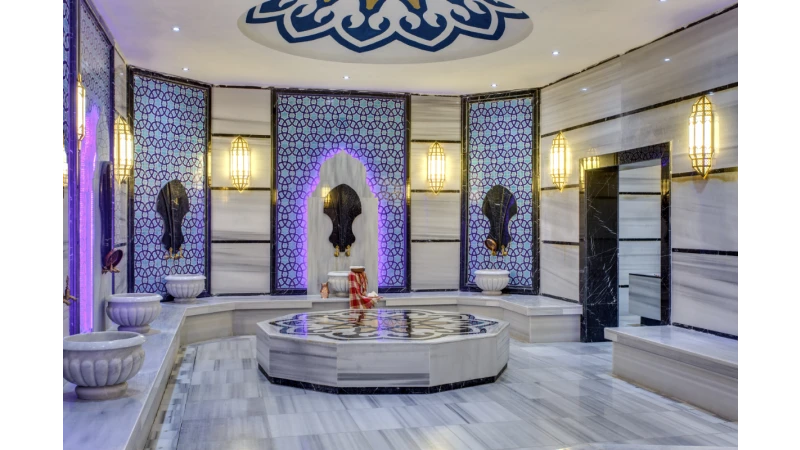Turkish Bath Experience – Historic Hamams & Spa Rituals

Traditional Turkish Bath (Hamam) Experience – A Journey into Relaxation & History
Introduction
The Turkish Bath (Hamam) is one of the most authentic cultural experiences in Turkey. More than just a cleansing ritual, it is a tradition that has been practiced for centuries, combining relaxation, wellness, and social life.
A visit to a historic hamam offers travelers the chance to step back into Ottoman times and enjoy a steam-filled marble chamber, body scrub, foam massage, and relaxation ritual unlike any other spa in the world.
📍 Related Read: Turkish Night Show – Dinner & Cultural Experience
History of the Turkish Bath
Roman & Byzantine Roots
The hamam tradition originated from the Roman thermae (public baths) and Byzantine bathing culture.
Ottoman Development
When the Ottomans conquered Constantinople in 1453, they adopted and perfected this bathing ritual, turning it into a cultural and architectural masterpiece. Hamams became central to daily life, social gatherings, and purification rituals.
Social & Religious Role
- Before prayers and special occasions, Muslims would visit the hamam for purification.
- It was also a place for celebrations, such as bride’s hammam (gelin hamamı) before weddings.
- Over time, hamams became both community centers and wellness sanctuaries.
🔗 External Source: UNESCO – Intangible Cultural Heritage
Architecture of a Traditional Hamam
A historic hamam is not just about cleansing; it is also a work of art.
Key Sections
- Camekan (Entrance Hall): A lounge where guests undress and relax.
- Sıcaklık (Hot Room): The heart of the hamam, with heated marble platform (göbek taşı) where bathers lie down for sweating and massages.
- Külhan (Furnace): The heating system that warms the marble and creates steam.
- Soğukluk (Cooling Room): A place to rest and drink tea after the ritual.
Design Features
- Domed ceilings with star-shaped skylights
- White or gray marble interiors
- Decorative fountains and basins (kurna) for water rituals
📍 Related Read: Basilica Cistern – Underground Wonder of Istanbul
What Happens in a Turkish Bath Experience?
- Changing & Preparation – Guests change into a pestemal (traditional cotton towel).
- Steam & Relaxation – Sit in the hot marble chamber to sweat and open pores.
- Body Scrub (Kese) – The attendant exfoliates the skin using a rough glove, removing dead skin cells.
- Foam Massage (Köpük Masajı) – The highlight of the hamam, a full-body massage with bubbles.
- Relaxation – Enjoy herbal tea or Turkish coffee in the lounge after treatment.
📍 Related Experience: Turkish Coffee Tasting – UNESCO Heritage Experience
Famous Historic Hamams in Turkey
Istanbul
- Çemberlitaş Hamamı – Built in 1584 by Mimar Sinan
- Cağaloğlu Hamamı – Famous for hosting sultans, writers, and celebrities
- Süleymaniye Hamamı – A unisex hamam popular among tourists
Cappadocia
- Boutique hamams offering traditional experiences combined with cave spa architecture.
Pamukkale
- Thermal hamam experiences using natural hot springs and travertine pools.
📍 Related Read: Pamukkale Travel Guide – Cotton Castle & Hierapolis
Why Try a Turkish Bath?
- Relaxation & Detox: Steam, scrub, and massage rejuvenate the body.
- Cultural Heritage: Experience a centuries-old Ottoman tradition.
- Wellness & Beauty: Improves circulation, deep cleansing, skin renewal.
- Social Ritual: Historically a place to connect with friends and family.
📍 Related Tour: Cappadocia Red Tour – Fairy Chimneys & Valleys
Tips for First-Time Visitors
- Bring a swimsuit or use the provided pestemal.
- Tipping attendants is customary.
- Don’t rush—allow 1.5–2 hours for the full experience.
- Women-only and men-only sections are common; some hamams are unisex.
- Inform attendants about any health conditions.
📍 Related Read: Bosphorus Dinner Cruise – Night Tour & Shows
SEO Optimized FAQ – Turkish Bath
1. What is a Turkish Bath (Hamam)?
A traditional Ottoman bathing ritual combining steam, scrub, and foam massage.
2. How long does a Turkish Bath take?
Usually 1.5–2 hours.
3. What do you wear in a hamam?
A pestemal (cotton towel) provided by the bath.
4. Is a Turkish Bath mixed-gender?
Most historic hamams separate men and women; some are unisex.
5. What is a kese?
The exfoliating glove used during the body scrub.
6. Is Turkish Bath good for health?
Yes, it improves circulation, detoxifies, and rejuvenates the skin.
7. Do I need to book in advance?
Yes, especially in popular hamams like Cağaloğlu or Çemberlitaş.
8. Can children go to a hamam?
Older children can, but many hamams have age restrictions.
9. How much does a Turkish Bath cost?
Standard hamams: €30–€50; luxury/spa-style hamams: €80–€150.
10. Is the Turkish Bath a UNESCO heritage?
It represents part of Turkey’s intangible cultural traditions recognized by UNESCO.
Conclusion
The Turkish Bath (Hamam) experience is a blend of history, wellness, and culture. From its Roman roots to its Ottoman golden age, the hamam remains one of Turkey’s most authentic traditions.
Whether in Istanbul’s historic hamams, Cappadocia’s boutique spas, or Pamukkale’s thermal baths, this ritual promises deep relaxation and cultural immersion.
No trip to Turkey is complete without experiencing the mystical world of the hamam.
📍 Related Experience: 6-Day Western Turkey Tour – Istanbul, Gallipoli, Ephesus & Pamukkale













